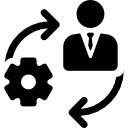System fundamentals: Difference between revisions
| Line 37: | Line 37: | ||
==== System Design and analysis ==== | ==== System Design and analysis ==== | ||
* | * [[Planning and stakeholder]] | ||
* | * [[Getting requirements from stakeholders]] (see also [[design process]]) | ||
* | * [[Gathering information for solutions]] (see also [[design process]]) | ||
* | * [[Illustrate system requirements]] (see also [[design process]]) | ||
* | * [[Prototypes]] (see also [[design process]]) | ||
* | * [[Iteration]] (see also [[design process]]) | ||
* | * [[Why end-users matter so much]] (see also [[design process]]) | ||
* | * [[Social and ethical issues associated with the introduction of new IT systems]] (see also [[design process]]) | ||
==== Human interaction with the system ==== | ==== Human interaction with the system ==== | ||
* 1.2.12 Define the term usability. Level: 1 | * 1.2.12 Define the term usability. Level: 1 | ||
Revision as of 13:07, 12 April 2016

System Fundamentals[1]
This is pretty straight forward stuff. Nothing especially technical. We are concerned with the big picture related how systems integrate into organisations and how people use them. I used the standards from the IB[2], but added some other topics I think fit into this category (but not included by the IB).
The big ideas in system fundamentals[edit]
Systems in Organizations[edit]
A computer program or computer system is used by people who work in organizations. It is very helpful to understand how people, computers, and organizations work together.
Planning and system installation[edit]
- System planning
- Change management
- Legacy system
- Testing implementation
- Installation process
- Data migration
- Testing
User Focus[edit]
System Backup[edit]
Software Deployment[edit]
System Design[edit]
Components of a computer system[edit]
- Hardware, software, peripheral, network, human resources
- Computers in a networked world
- Social and ethical issues in a networked world (also see ethics)
System Design and analysis[edit]
- Planning and stakeholder
- Getting requirements from stakeholders (see also design process)
- Gathering information for solutions (see also design process)
- Illustrate system requirements (see also design process)
- Prototypes (see also design process)
- Iteration (see also design process)
- Why end-users matter so much (see also design process)
- Social and ethical issues associated with the introduction of new IT systems (see also design process)
Human interaction with the system[edit]
- 1.2.12 Define the term usability. Level: 1
- 1.2.13 Identify a range of usability problems with commonly used digital devices. Level: 2
- 1.2.14 Identify methods that can be used to improve the accessibility of systems. Level: 2
- 1.2.15 Identify a range of usability problems that can occur in a system. Level: 2
- 1.2.16 Discuss the moral, ethical, social, economic and environmental implications of the interaction between humans and machines. Level: 3